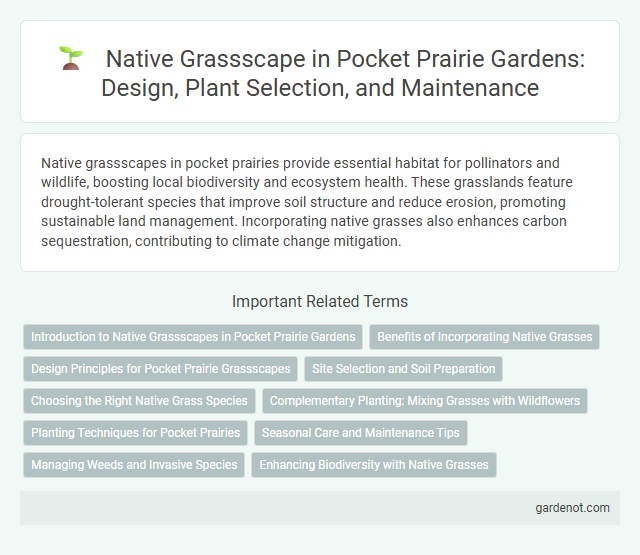Native grassscapes in pocket prairies provide essential habitat for pollinators and wildlife, boosting local biodiversity and ecosystem health. These grasslands feature drought-tolerant species that improve soil structure and reduce erosion, promoting sustainable land management. Incorporating native grasses also enhances carbon sequestration, contributing to climate change mitigation.
Introduction to Native Grassscapes in Pocket Prairie Gardens
Native grassscapes in pocket prairie gardens feature indigenous grasses such as Little Bluestem, Switchgrass, and Indian Grass that thrive in local climates while supporting biodiversity. These grasses improve soil health, reduce erosion, and provide essential habitats for pollinators and wildlife, enhancing ecological balance. Incorporating native grassscapes into pocket prairies promotes sustainable landscaping that requires minimal maintenance and conserves water resources.
Benefits of Incorporating Native Grasses
Incorporating native grasses into pocket prairies enhances biodiversity by providing essential habitat for pollinators and wildlife. These grasses improve soil health through deep root systems that prevent erosion and increase water retention. Native grasses also require less maintenance and water compared to non-native species, contributing to sustainable landscaping practices.
Design Principles for Pocket Prairie Grassscapes
Design principles for pocket prairie grassscapes emphasize selecting native grass species that promote biodiversity and resilience, such as little bluestem, switchgrass, and Indian grass. Incorporating diverse plant heights and root structures enhances soil health, supports pollinators, and improves stormwater management. Strategic placement of grasses ensures optimal sunlight exposure and aesthetic appeal while fostering sustainable urban ecosystems.
Site Selection and Soil Preparation
Site selection for a pocket prairie emphasizes well-drained soils with full to partial sunlight exposure to support native grassscape diversity. Soil preparation involves minimal disturbance, removing invasive species and loosening the topsoil to promote root establishment while preserving native microbial communities. Incorporating organic matter enhances soil fertility and moisture retention, optimizing conditions for native grass growth.
Choosing the Right Native Grass Species
Selecting the right native grass species for a pocket prairie involves considering local climate, soil type, and ecological benefits to ensure optimal growth and biodiversity support. Species like Little Bluestem (Schizachyrium scoparium), Switchgrass (Panicum virgatum), and Indian Grass (Sorghastrum nutans) are well-suited for many regions and provide habitat for pollinators and wildlife. Proper selection enhances soil health, conserves water, and creates a sustainable, low-maintenance native grassscape.
Complementary Planting: Mixing Grasses with Wildflowers
Complementary planting in pocket prairies combines native grasses like Little Bluestem and Indian Grass with wildflowers such as Purple Coneflower and Black-eyed Susan, enhancing biodiversity and providing year-round habitat for pollinators. This diverse plant palette improves soil health, reduces erosion, and creates visually appealing landscapes that support local ecosystems. Strategic mixing of grasses and wildflowers maximizes ecological benefits while requiring minimal maintenance.
Planting Techniques for Pocket Prairies
Effective planting techniques for pocket prairies emphasize native grassscapes, utilizing deep-rooted species such as little bluestem (Schizachyrium scoparium) and switchgrass (Panicum virgatum) to enhance soil health and biodiversity. Timing seeding in late fall or early spring mimics natural germination cycles, improving establishment success and reducing weed competition. Precision in site preparation, including minimal soil disturbance and targeted seed-to-soil contact, maximizes growth potential and sustainability of native grass ecosystems.
Seasonal Care and Maintenance Tips
Native grassscapes in pocket prairies require seasonal care focused on promoting healthy growth and biodiversity. In early spring, remove accumulated dead foliage to allow sunlight penetration and stimulate new shoots. Late fall mowing or burning helps manage invasive species, recycle nutrients, and prepare the grassscape for dormancy while preserving root and seed health for the following growing season.
Managing Weeds and Invasive Species
Effective management of weeds and invasive species in a native grassscape involves regular monitoring and targeted removal to preserve biodiversity and ecosystem balance. Employing techniques such as selective herbicide application, mulching, and manual pulling helps control unwanted plants without harming native grasses. Promoting healthy growth of native species through proper soil preparation and watering enhances their competitive advantage against invasives.
Enhancing Biodiversity with Native Grasses
Native grassscapes in pocket prairies play a crucial role in enhancing biodiversity by providing habitat and food sources for pollinators, birds, and beneficial insects. Deep-rooted native grasses improve soil health and water retention, fostering a resilient ecosystem. Incorporating diverse native grass species promotes ecological balance and supports local wildlife populations.
Native grassscape Infographic

 gardenot.com
gardenot.com